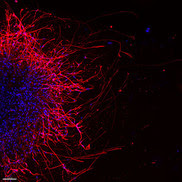

Science Advances
A Cancerous Conversation Fuels Oral Tumors

NIDCR-supported research revealed a new role for nerves in oral cancer progression, whereby tumor cells send genetic messages that transform nerves into cancer-promoting agents. Targeting this nerve-tumor crosstalk could lead to more effective treatments for people with head and neck cancer.
|
Cell Machines Pave the Way to Solving A Molecular Mystery

Kenneth Yamada, MD, PhD, and his NIDCR lab have discovered a new type of cellular machinery that plays a critical role in laying down a sticky, fibrous substance called fibronectin. This substance helps cells attach to and migrate along basement membranes, which enclose tissues and organs. Yamada speculates that the fibronectin deposits assist organ formation during embryonic development and may also contribute to cancer cells’ ability to invade tissues.
|
What Governs Secretion?

The lowly little fruit fly is providing insights into the biology of cells’ secretion of proteins vital to life. NIDCR’s Kelly Ten Hagen, PhD, and her lab have shown in Drosophila (fruit flies) that formation of secretory granules, the cellular packets that store proteins destined for secretion, depends on a protein called Tango1. These basic science advances could help researchers better understand secretion-related defects that lead to dry mouth disorders.
|
Newly Identified Oral Stem Cell Key to Wound Healing

Findings from an NIDCR-funded mouse study may help explain why the mouth heals faster than the skin. The scientists discovered a unique population of stem cells in the roof of the mouth that respond quickly to repair injury to the hard palate. The research, published in Cell Stem Cell, may provide insights into wound healing throughout the body.
|
Salivary Gland Diversity Starts Surprisingly Early
 |
Very early in development, diverse salivary glands emerge, each capable of a specific job. NIDCR researchers found that this diversity is underscored by differences in muscle- and nerve-related gene expression in mouse embryonic salivary glands. The researchers say their insights may help with future tissue engineering efforts to repair damaged salivary glands.
|






















.png)











No hay comentarios:
Publicar un comentario